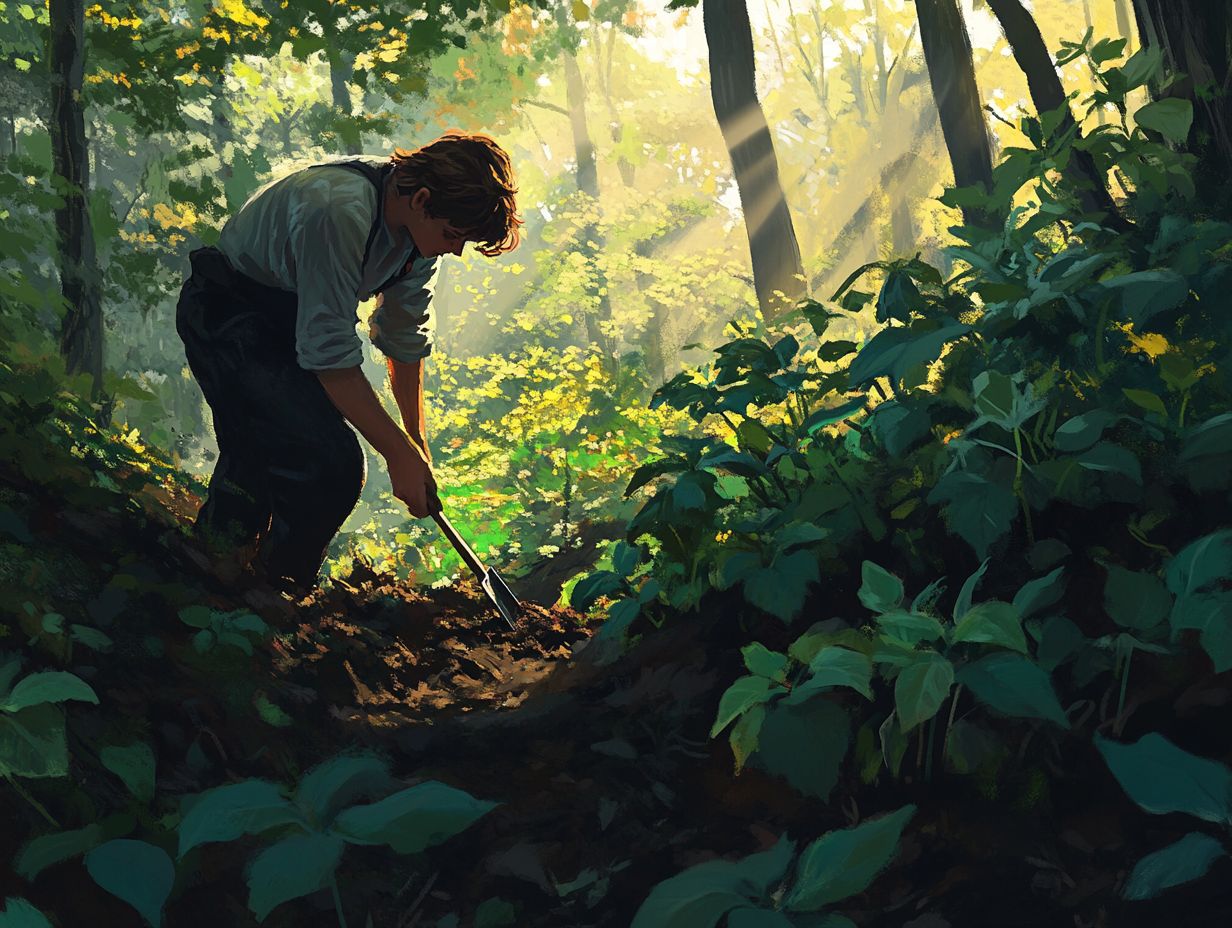Foraging Techniques for Edible Roots
Foraging for roots offers you a rewarding and adventurous opportunity to connect with nature while uncovering hidden culinary gems.
This guide delves into the myriad benefits of foraging, identifies common edible roots, and outlines essential precautions to ensure a safe and enjoyable experience. It also covers the necessary tools, sustainable practices for responsible foraging, and delectable methods for preparing your finds.
Embark on a journey into the fascinating world of edible roots!
Contents
- Key Takeaways:
- Benefits of Foraging for Roots
- Identifying Edible Roots
- Foraging Safety
- Tools and Equipment for Foraging
- Sustainable Foraging Practices
- Preparing and Cooking Edible Roots
- Frequently Asked Questions
- What are some common foraging techniques for edible roots?
- How do I identify which roots are edible?
- What tools do I need for foraging edible roots?
- Are there any safety precautions I should take when foraging for edible roots?
- When is the best time of year to forage for edible roots?
- Can I forage for edible roots on public land?
Key Takeaways:

- Foraging for edible roots can provide numerous benefits, including access to fresh, nutrient-rich food and a connection to nature.
- Properly identifying edible roots in the wild is crucial before consuming them. Common types include dandelion, burdock, and wild carrot.
- Before embarking on a foraging trip, follow safety precautions and bring essential gear such as a knife, gloves, and a field guide.
Benefits of Foraging for Roots
Foraging for roots presents a wealth of benefits that extend beyond mere nutrition. It nurtures a profound connection to nature that can elevate both physical health and mental well-being.
By engaging in this enriching activity, you can discover a range of nutrient-rich foods, such as Dandelion and Chickweed, while championing sustainable foraging practices that honor wild ecosystems.
Gathering food from nature ignites a sense of adventure, inspires outdoor exploration, and bolsters the local foods movement, transforming foraging into a deeply satisfying and meaningful endeavor.
Identifying Edible Roots
Learning to identify edible roots is an exciting adventure for anyone passionate about foraging. It demands a discerning eye and a deep understanding of wild plants and their unique characteristics, including foraging techniques for seasonal vegetables.
Mastering plant identification helps you avoid the pitfalls of consuming toxic varieties and enhances your foraging adventures.
With this knowledge, you can confidently recognize familiar edible plants like Dandelion and wild carrot, transforming your outings into safe and rewarding experiences.
Common Types of Edible Roots
You can find several common types of edible roots in the wild, each offering unique flavors and nutritional benefits. Among these treasures is Dandelion, renowned for its versatility in the kitchen, and wild carrots, which are prized for their sweetness and rich nutrients.
Beyond these favorites, you may also discover burdock, whose tender young roots are not only a culinary delight but also brimming with antioxidants. Another intriguing option is the sweet potato, celebrated for its natural sweetness and impressive levels of beta-carotene, great for supporting eye health.
Don t overlook the lesser-known sunchoke, or Jerusalem artichoke, which presents a nutty flavor along with prebiotic properties that can enhance gut health. Each of these roots can enrich your balanced diet, providing essential vitamins and minerals while elevating the flavors of your dishes.
How to Identify Edible Roots in the Wild
To successfully identify edible roots in the wild, you must use a blend of visual recognition, tactile assessment, and a solid understanding of the plant’s growing environment. This process demands a keen eye and a wealth of foraging techniques for edible trees while adhering to safety guidelines to steer clear of poisonous plants.
Starting with research is crucial as it helps you recognize the distinguishing features of various roots. When you’re out foraging, look for plants with robust foliage; healthy leaves often hint at the delicious roots hiding just beneath the surface. Learning foraging techniques for medicinal plants can enhance your experience and knowledge in this rewarding activity.
Tactile evaluation is vital; feeling the texture of the roots can reveal whether they are tender and nutritious. Don t forget to trust your nose many edible varieties emit a delightful aroma, while toxic plants often give off an unpleasant scent.
Understanding the habitat, including soil type and moisture levels, is also key. This knowledge helps you identify the ideal environments where these edible roots thrive, ensuring a safe and fruitful foraging experience.
Foraging Safety

Foraging safety is essential for cultivating a positive and healthy experience as you venture into the great outdoors in search of wild edibles. It starts with a thorough grasp of safety guidelines.
By familiarizing yourself with how to identify poisonous plants and utilizing a simple test to check if a plant is safe to eat, you can significantly mitigate health risks. This knowledge not only protects you but also enriches your foraging journey, giving you the power to gather wild food with confidence and assurance.
Precautions and Tips for Safe Foraging
To ensure a safe foraging experience, it’s essential to take specific precautions and embrace tips that enhance your awareness of the wild edible plants you encounter. Foraging safety begins with recognizing how to steer clear of poisonous plants and mastering good harvesting techniques, which safeguard your health and foster sustainable practices.
Being well-informed about local plants is crucial, as many regions boast unique species that may pose risks. To deepen this knowledge, consider enrolling in workshops or joining local foraging groups, where seasoned foragers can share invaluable insights.
Always keep a reliable field guide on hand to accurately identify plants and avoid look-alikes that could be toxic. Foraging in areas away from heavy foot traffic or pollution will also help minimize risks.
When in doubt, leave the plant untouched, prioritizing your safety over the thrill of adventure.
Tools and Equipment for Foraging
Having the right tools makes foraging both easier and more enjoyable. Here are the essentials to bring along:
- Baskets for collecting your foraged treasures,
- Pruning shears for effortlessly harvesting roots,
- Field guides for accurate plant identification.
Each of these tools plays a vital role in ensuring a successful and rewarding foraging experience.
Essential Gear for Successful Foraging
Essential gear for successful foraging includes a curated selection of tools designed to elevate your experience in gathering, identifying, and preparing wild foods. A sturdy basket is critical for collecting edible plants, while a reliable knife is crucial for slicing roots with precision.
Consider donning gloves to shield your hands from prickly plants. Don t overlook the utility of a small shovel, which can assist you in unearthing tubers or mushrooms nestled in the earth.
If you re wandering through wooded areas, a compass or GPS device can be invaluable for keeping you on track.
After your foraging excursion, a portable cooler or insulated bag ensures that your treasures, like berries or greens, remain fresh until you re ready to whip up delightful recipes. By equipping yourself with these essential items, you can gather nature s bounty and transform it into nourishing and delicious meals.
Sustainable Foraging Practices
Sustainable foraging practices are essential for preserving wild ecosystems and ensuring that future generations can relish the joys of foraging while minimizing environmental impact.
By mastering the art of responsible and ethical plant harvesting, you can actively contribute to the health of local ecosystems and champion biodiversity the variety of different plants and animals in an area in your community.
How to Forage Responsibly

Foraging responsibly means using sustainable practices. This helps maintain the health of wild plants and ecosystems while you enjoy gathering your own food.
By employing smart ways to gather plants, you can minimize habitat damage. This ensures the longevity of edible plants, creating a harmonious relationship with nature.
This commitment to thoughtful foraging involves not just taking what you need. Respecting the delicate balance of the environment is essential.
Make sure to learn about which species are common and which need protection. Utilize methods that promote growing back. For instance, when you’re collecting mushrooms or berries, leave enough behind to support wildlife and encourage plant reproduction.
Keep your tools and hands clean! This prevents spreading diseases and keeps ecosystems healthy. By practicing mindfulness in your foraging endeavors, you contribute to preserving biodiversity.
Preparing and Cooking Edible Roots
Preparing and cooking edible roots can truly be an art form! This allows you to transform your foraged finds into exquisite and nutritious meals that honor nature’s bounty.
By mastering the various techniques for cleaning and cooking roots whether you choose to boil, roast, or incorporate them into traditional recipes you can fully appreciate the rich flavors and nutritional benefits of your harvest.
Methods for Cleaning and Cooking Roots
Cleaning and cooking roots is a fun process! This lets you enjoy their natural flavors and nutrients, making them safe and enjoyable to eat.
To start, gently scrub each root under running water. This is especially important for roots that grow in the soil, like carrots and beets. After cleaning, peel them to enhance the dish’s overall texture.
For cooking, steaming is a great way to retain vital vitamins. Roasting can draw out the natural sweetness of roots such as sweet potatoes and parsnips. For a touch of creativity, think about adding these nutritious roots to hearty soups or stews. This allows their flavors to meld seamlessly with other ingredients and elevate your dish to new heights.
Frequently Asked Questions
What are some common foraging techniques for edible roots?
Common foraging techniques for edible roots include digging with a shovel or garden fork, using a trowel or knife to carefully unearth roots, and pulling roots by hand. For more detailed strategies, check out our guide on foraging for edible roots: seasonal insights.
How do I identify which roots are edible?

Always identify edible roots before foraging. Look for characteristics such as size, color, texture, and smell to determine if a root is safe to eat. Consulting a field guide or expert can also help, along with using foraging techniques for plant identification.
What tools do I need for foraging edible roots?
Essential tools for foraging edible roots include a shovel, garden fork, trowel, knife, gloves, and a basket or bag to collect the roots in. Additionally, learning foraging techniques for wild greens can enhance your skills, and having a field guide or plant identification app on hand is also helpful.
Are there any safety precautions I should take when foraging for edible roots?
Yes, taking safety precautions while foraging for edible roots is crucial. Always wear gloves to protect your hands. Be mindful of potential hazards such as poison ivy or thorny plants. Additionally, learning foraging techniques for wilderness survival can help ensure you properly identify the roots before consuming them, which is vital.
When is the best time of year to forage for edible roots?
The best time to forage for edible roots is typically in late summer or fall, when the plant’s energy is concentrated in the roots. For more detailed guidance, check out identifying edible roots: what to look for. Some roots can also be foraged in the spring.
Can I forage for edible roots on public land?
It’s important to check with local authorities before foraging for edible roots on public land. Some areas may have restrictions or regulations in place. Always obtain permission from the landowner before foraging on private property.






